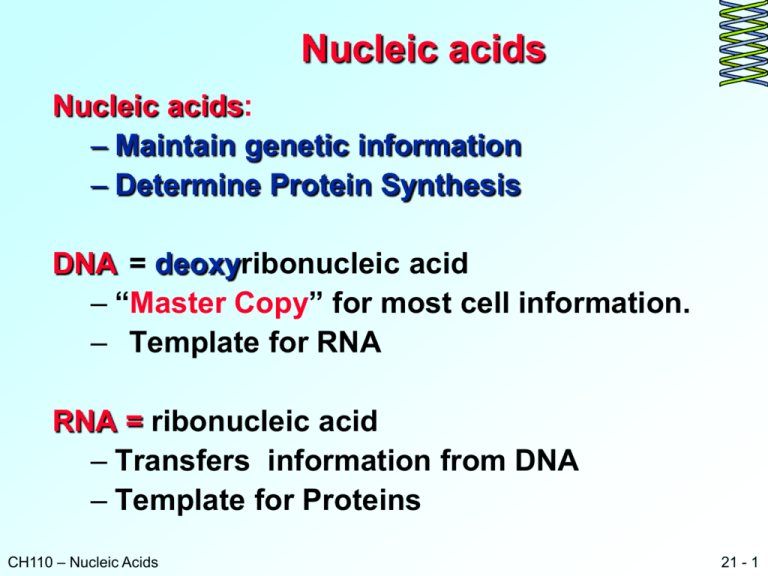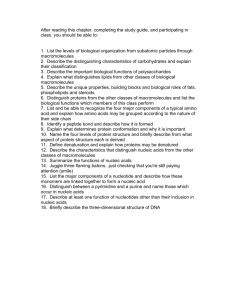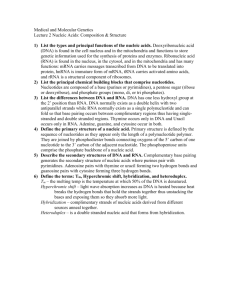The nucleic acids - faculty at Chemeketa
advertisement

Nucleic acids Nucleic acids: – Maintain genetic information – Determine Protein Synthesis DNA = deoxyribonucleic acid – “Master Copy” for most cell information. – Template for RNA RNA = ribonucleic acid – Transfers information from DNA – Template for Proteins CH110 – Nucleic Acids 21 - 1 Nucleic Acids Chromosomes (in nucleus) Have genes 1 gene 1 enzyme Enzymes determine external & internal characteristics CH110 – Nucleic Acids 21 - 2 NUCLEIC ACIDS Long chains (polymers) of repeating nucleotides. – Each nucleotide has 3 parts: A heterocyclic Amine Base N O HO P OH H HO O O OH H A phosphate unit H H H OH CH110 – Nucleic Acids H A sugar H 21 - 3 Nucleotide = phosphate + sugar + base Phosphate Base O O P N Sugar O O O H -N-glycosidic linkage H H H OH H Nucleoside = sugar + base CH110 – Nucleic Acids 21 - 4 Nucleic Acids Nucleic Acids = polymers of Nucleotides. base B P S B P S B P S B P phosphate CH110 – Nucleic Acids S B B P S P S sugar 21 - 5 THE SUGAR PART • The major difference between RNA and DNA is the different form of sugar used. Ribose C5H10O5 in RNA O HOCH2 H OH H H OH OH H DeoxyRibose C5H10O4 in DNA O HOCH2 H OH H H OH H H The difference is at carbon #2. CH110 – Nucleic Acids 21 - 6 The Nitrogenous Bases 5 bases used fall in two classes Purines & Pyrimidines N N N N N N H A double ring A single ring (6 & 5 members) (6 membered) CH110 – Nucleic Acids 21 - 7 The Nitrogenous Bases NH2 Purines: N N Adenine (A) O H N H2N H N N Thiamine (T) In DNA only N N N N Guanine (G) H NH2 O CH3 H CH110 – Nucleic Acids N O Pyrimidines: H O H O H N N H Uracil (U) In RNA only O N N H Cytosine (C) 21 - 8 Nucleotides Di- & Tri- Phosphates NH2 Adenine N N O HO P OH OH O HO P O N N O 5' O 4' H H 3' ribose OH 1' H H 2' OH Adenosine 5’-monophosphate (AMP) CH110 – Nucleic Acids 21 - 9 Nucleotides Di- & Tri- Phosphates NH2 Adenine N N O HO P OH OH O O HO P O P O O N N O 5' O 4' H H ribose 3' OH 1' H H 2' OH Adenosine 5’-monophosphate (AMP) Adenosine 5’-diphosphate (ADP) CH110 – Nucleic Acids 21 - 10 Nucleotides Di- & Tri- Phosphates NH2 Adenine N N O O O HO P O P O P O O Adenosine 5’-triphosphate (ATP) O N N O 5' O 4' H H ribose 3' OH 1' H H 2' OH Adenosine 5’-monophosphate (AMP) Adenosine 5’-diphosphate (ADP) CH110 – Nucleic Acids 21 - 11 NH2 OH O P O N N O Primary structure N N 5' O 4' H H 3' OH H 1' H O 2' H N HN OH O P O H2N O N N 5' O 4' H H 3' OH H 1' 2' H P O CH110 – Nucleic Acids N O O CH3 N OH O O H 5' O 4' H H 3' OH H 1' H 2' H 21 - 12 Primary structure NH2 5’ OH O P O N O 5' O 4' H H 3' O O P O Phosphate bonds link DNA or RNA nucleotides together in a linear sequence. CH110 – Nucleic Acids Adenine (A) Similar to proteins N with their peptide bonds and side H 1' H groups. O 2' H N Guanine (G) HN N N H2N O N N 5' O 4' H H 3' P O 3’ O H 2' H O O Thymine (T) 1' H O O CH3 N N 5' O 4' H H 3' OH H 1' H 2' H 21 - 13 Base pairing and hydrogen bonding H-N N N N-H guanine N cytosine N N N-H H 3C H thymine N H | N- H N N adenine N N CH110 – Nucleic Acids N 21 - 15 DNA - Secondary Structure Complementary Base Pairing Position of H bonds and distance match with: CH110 – Nucleic Acids 21 - 16 Hydrogen bonding Each base wants to form either two or three hydrogen bonds. That’s why only certain bases will form pairs. C G T A G C G A CH110 – Nucleic Acids C T 21 - 17 Sugarphosphate backbone DNA coils around outside of attached bases like a spiral stair case. Results in a double helix structure. CH110 – Nucleic Acids 21 - 18 The double helix The combination of the stairstep sugarphosphate backbone and the bonding between pairs results in a double helix. Distance between bases = 0.34 nm CH110 – Nucleic Acids One complete twist is 3.4 nm 2 nm between strands 21 - 19 DNA - Secondary Structure Complementary Base Pairing CH110 – Nucleic Acids 21 - 20 • Crick and Watson (1962 Nobel Prize) – Proposed the basic structure of DNA – 2 strands wrap around each other – Strands are connected by H-bonds between the amines. • Like steps of a spiral staircase CH110 – Nucleic Acids 21 - 22 Chromosomes Chromosomes consists of DNA strands coiled around protein - histomes. The acidic DNA’s are attracted to the basic histones. CH110 – Nucleic Acids 21 - 23 CH110 – Nucleic Acids 21 - 24 Chromosomes The normal number of chromosome pairs varies among the species. Animal Man Cat Mouse Rabbit Honeybee, male female CH110 – Nucleic Acids Pairs 23 30 20 22 8 16 Plant Onion Rice Rye Tomato White pine Adder’s tounge fern Pairs 8 14 7 12 12 1262 21 - 25 DNA: Self - Replication P S P A S G P S T P P S C S C P S G C T CH110 – Nucleic Acids G A 21 - 28 DNA: Self - Replication P S P A T CH110 – Nucleic Acids S G C P S P S T C A G P S C G P S G C 21 - 29 Replication of DNA Replication occurs on both halves in opposite directions. CH110 – Nucleic Acids 21 - 30 DNA Replication CH110 – Nucleic Acids 21 - 31 RNA synthesis In the first step, RNA polymerase binds to a promotor sequence on the DNA chain. This insures that transcription occurs in the correct direction. The initial reaction is to separate the two DNA strands. CH110 – Nucleic Acids 21 - 32 RNA synthesis initiation sequence termination sequence ‘Special’ base sequences in the DNA indicate where RNA synthesis starts and stops. CH110 – Nucleic Acids 21 - 33 RNA synthesis Once the termination sequence is reached, the new RNA molecule and the RNA synthase are released. The DNA recoils. CH110 – Nucleic Acids 21 - 34 • The messenger RNA (mRNA) move outside the nucleus to the cytoplasm where Ribosomes are anxiously awaiting their arrival. 60 S rRNA rRNA 40 S CH110 – Nucleic Acids 21 - 35 • The messenger RNA (mRNA) move outside the nucleus to the cytoplasm where Ribosomes are anxiously awaiting their arrival. 60 S rRNA rRNA 40 S CH110 – Nucleic Acids 21 - 36 • The messenger RNA (mRNA) move outside the nucleus to the cytoplasm where Ribosomes are anxiously awaiting their arrival. 60 S rRNA rRNA 40 S CH110 – Nucleic Acids 21 - 37 • The messenger RNA (mRNA) move outside the nucleus to the cytoplasm where Ribosomes are anxiously awaiting their arrival. 60 S rRNA rRNA 40 S CH110 – Nucleic Acids 21 - 38 Ribosomal RNA – rRNA: Platform for protein synthesis. Holds mRNA in place and helps assemble proteins. 60 S rRNA rRNA 40 S CH110 – Nucleic Acids 21 - 39 •The Ribosomes are like train stations –The mRNA is the train slowly moving through the station. 60 S rRNA Codons AUG GCU AUG 5’ UUG 3’mRNA rRNA 40 S CH110 – Nucleic Acids 21 - 40 Transfer RNA - tRNA = • relatively small compared to other RNA’s (70-90 bases.) • transports amino acids to site of protein synthesis. HO- A C C A G G A U G U C G G U A C G C G G U C G C G U C G G C U U G C A G G C C U C C G G C C G C U G U A G G C G C U U U C G A G U A C G C G C G G G C G C CH110 – Nucleic Acids 21 - 41 Anticodons on t-RNA HO- C Site of amino acid attachment G A U G U C G G U Three base anticodon site A C G G C C A C G G U G C G C G U C G G C U U G C A G G C C U U A G U C G C C C G G C G C U G C G U A C G C G C G A U G U G C CH110 – Nucleic Acids A G C G Point of attachment to mRNA 21 - 42 Amino acid codons alanine GCA, GCC, GCG GCU, AGA, AGG arginine AGA, AGG, CGA CGC, CGG, CGU asparagine AAC, AAU aspartate GAC, GAU cysteine UGC, UGU glutamate GAA, GAG glutamine CAA, CAG glycine GAA, GCC, GGG GGU histidine CAC, CAU isoleucine AUA, AUC, AUU leucine CUA, CUC, CUG CUU, UUA, UUG CH110 – Nucleic Acids lysine AAA, AAG methionine AUG phenylalanine UUC, UUU proline CCA, CCC CCG, CCU serine UCA, UCC UCG, UCU AGC, AGU threonine ACA, ACC ACG, ACU tryptophan UGG tyrosine UCA, UCU valine GUA, GUC GUG, GUU 21 - 43 Protein Synthesis 1: Activation Each AA is activated by reacting with an ATP The activated AA is then attached to particular tRNA... (with the correct anticodon) activated AA anticodon CH110 – Nucleic Acids fMET C G A 21 - 45 Translation fMET 60S U A C AUG Initiation factors CH110 – Nucleic Acids 5’ GCU AUG UUG mRNA 3’ Psite A site 40S ribosome unit 21 - 46 Translation Ala fMET 60S C G A U A C AUG 5’ GCU AUG UUG mRNA 3’ Psite A site 40S ribosome unit CH110 – Nucleic Acids 21 - 47 Translation peptide bond forms fMET Ala U A C C G A AUG GCU AUG UUG mRNA 3’ 5’ ribosome unit CH110 – Nucleic Acids 21 - 48 Translation U A C Amino Acid peptide bond Met Ala Z Z Z U A C UG A C G A GCU UUC UUG mRNA 3’ 5’ ribosome unit CH110 – Nucleic Acids 21 - 49 Translation peptide bond forms U A C Met UG A Ala ??? C G A ? ? ? GCU UUC UUG mRNA 3’ 5’ ribosome unit CH110 – Nucleic Acids 21 - 50 Recombinant DNA Bacterium Remove gene segment DNA Plasmid sticky ends Cut gene for insulin Replace in bacterium CH110 – Nucleic Acids 21 - 53 Learning Check What is the sequence of bases in mRNA produced from a section of the template strand of DNA that has the sequence of bases: 3’–C–T–A–A–G–G–5’? 1. 5’–G–A–T–T–C–C–3’ 2. 5’–G–A–U–U–C–C–3’ 3. 5’–C–T–A–A–G–G–3’ CH110 – Nucleic Acids 54 21 - 54 Solution What is the sequence of bases in mRNA produced from a section of the template strand of DNA that has the sequence of bases: 3’–C–T–A–A–G–G–5’? 3’–C–T–A–A–G–G–5’? 2. 5’–G–A–U–U–C–C–5’ CH110 – Nucleic Acids 55 21 - 55 Learning Check The following section of DNA is used to build a mRNA for a protein. 3’—GAA—CCC—TTT—5’ A. What is the corresponding mRNA sequence? B. What are the anticodons on the tRNAs? C. What is the amino acid order in the peptide? 56 CH110 – Nucleic Acids 21 - 56 Solution 3’—GAA—CCC—TTT—5’ DNA A. What is the corresponding mRNA sequence? 5’—CUU—GGG—AAA—3’ mRNA B. What are the anticodons for the tRNAs? mRNA codons CUU GGG AAA tRNA anticodons GAA CCC UUU C. What is the amino acid order in the peptide? mRNA 5’—CUU—GGG—AAA—3’ Leu — Gly — Lys 57 CH110 – Nucleic Acids 21 - 57



